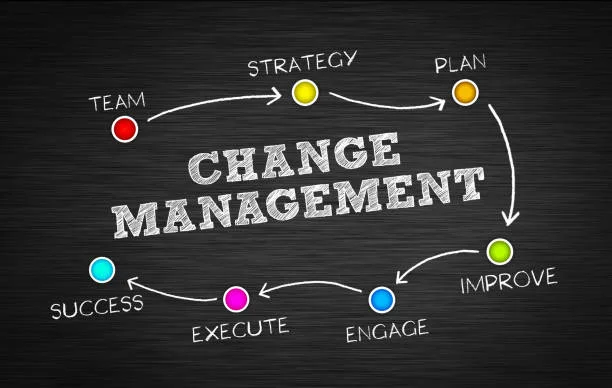Change happens whether you’re ready or not. But there’s a massive difference between chaos and controlled change. I’ve watched companies stumble through major transitions, losing money and people along the way, simply because they didn’t have a solid process in place. Building an effective change management process isn’t about fancy frameworks or corporate buzzwords – it’s about creating a system that actually helps people navigate uncertainty. Research from Prosci shows that organizations with excellent change management are 6 times more likely to meet project objectives than those with poor change management. That’s not a small difference.
Start With Change Readiness Assessment
Before you change anything, you need to understand where your organization currently stands. This isn’t just asking people if they’re ready for change – most will say yes even when they’re not.
Look at recent change history. How did the last major change go? If people are still complaining about the software rollout from two years ago, that tells you something important about their change tolerance and your organization’s track record.
Assess leadership alignment first. If senior leaders aren’t on the same page about why change is needed, employees will sense that disconnect immediately. Leadership alignment surveys should be anonymous and include specific questions about commitment levels, not just general support.
Evaluate current workload and stress levels. Timing matters enormously in change management. Trying to implement major changes during busy seasons or when teams are already stretched thin is asking for failure.
Don’t miss today’s featured post—discover unique insights.
Map Your Stakeholder Landscape
Not all stakeholders are created equal, and treating them the same way guarantees problems. Create a detailed map that identifies who will be affected, how much influence they have, and what their likely reaction will be.
Champions are your early adopters who will help sell the change to others. Identify these people early and give them insider access to information and decision-making. They become your informal communication network.
Resisters aren’t necessarily bad people – they often have valid concerns that need addressing. Engage with them directly to understand their objections. Sometimes resistance comes from lack of information, sometimes from legitimate operational concerns.
Neutral parties make up the majority in most organizations. They’ll follow the lead of champions or resisters depending on how change is handled. This group is where you win or lose the change effort.
Design Your Communication Strategy
Communication in change management isn’t about sending more emails – it’s about creating understanding and buy-in through multiple channels and repeated messages.
The “why” comes first and gets repeated constantly. People need to understand not just what’s changing, but why it’s necessary and what happens if nothing changes. Use concrete examples and real data, not vague statements about “staying competitive.”
Timing your communications matters more than most people realize. Share information as soon as decisions are made, but don’t overwhelm people with details they can’t act on yet. Create a communication calendar that matches your implementation timeline.
Two-way communication is essential. Town halls, feedback sessions, and anonymous survey tools give people ways to express concerns and ask questions. When people feel heard, they’re more likely to support change even if they don’t love it.
Create Learning and Support Systems
Change requires new skills, knowledge, or behaviors. People can’t just figure it out as they go – they need structured support to be successful.
Skills gap analysis should happen early in the process. What capabilities do people need that they don’t currently have? This analysis drives training design and identifies who needs additional support.
Multiple learning formats work better than one-size-fits-all training. Some people learn from hands-on practice, others from written materials or video tutorials. Offer options and let people choose what works best for them.
Peer support networks often work better than formal training for ongoing skill development. Pair experienced users with newcomers, create user groups, and encourage informal knowledge sharing.
Build Feedback Loops and Adjustment Mechanisms
No change plan survives contact with reality unchanged. Build mechanisms to detect problems early and make course corrections before small issues become major disasters.
Regular pulse surveys track sentiment and adoption progress. Keep surveys short – 5-7 questions max – and focus on specific, actionable feedback rather than general satisfaction ratings.
Operational metrics tell you if the change is actually working. If the new process was supposed to improve efficiency, measure efficiency. If it was meant to reduce errors, track error rates. Don’t just measure adoption – measure results.
Escalation paths give people ways to report serious problems without going through normal channels. Sometimes the people managing change are the last to hear about major issues because employees don’t want to be seen as complainers.
Establish Success Metrics and Milestones
Success in change management isn’t just about completing implementation – it’s about achieving the intended outcomes and maintaining them over time.
Leading indicators predict future success better than lagging indicators. Training completion rates, early adopter feedback, and usage statistics tell you how things are trending before final results are clear.
Behavioral changes often lag behind process changes. People might follow new procedures but not fully embrace new ways of thinking. Track both compliance and engagement to get the full picture.
Long-term sustainability metrics matter most. How well are new practices maintained six months or a year later? Many change efforts succeed initially but fade when attention moves elsewhere.
Curious for more? Explore engaging content that sparks ideas on Management Works Media today.






